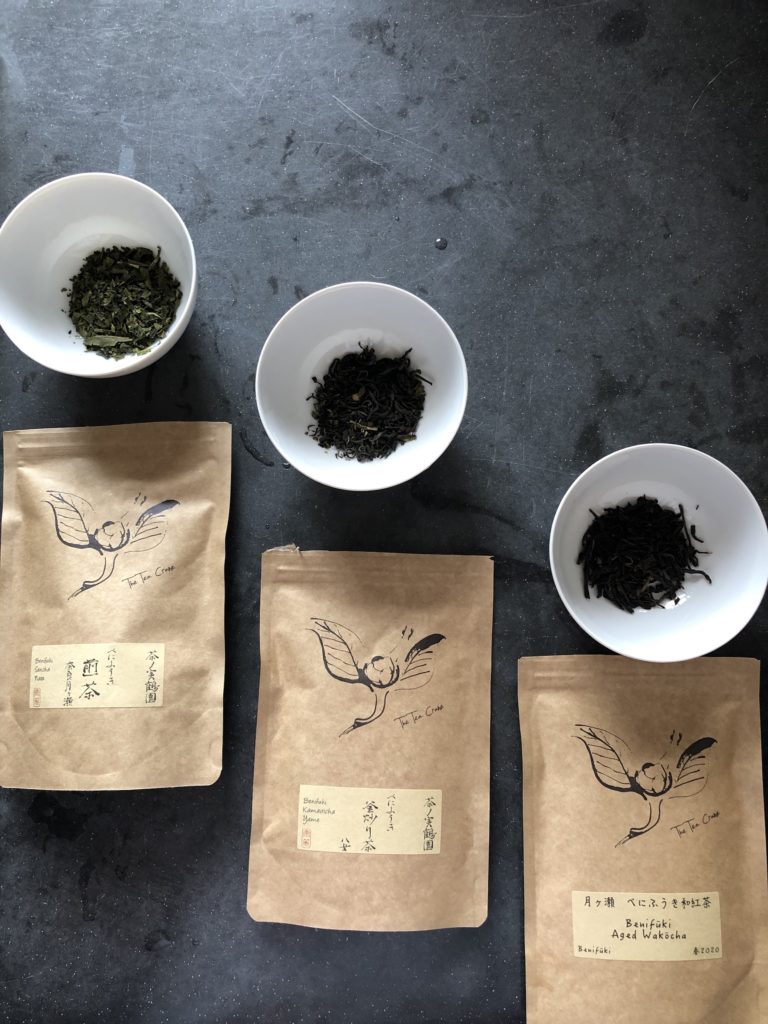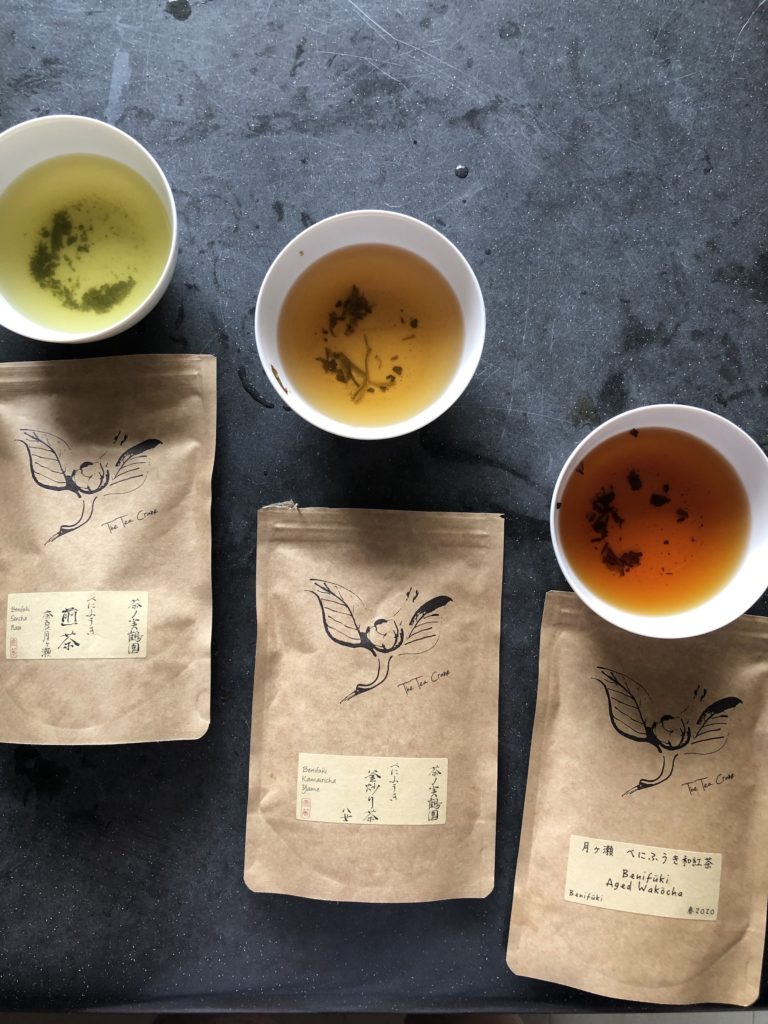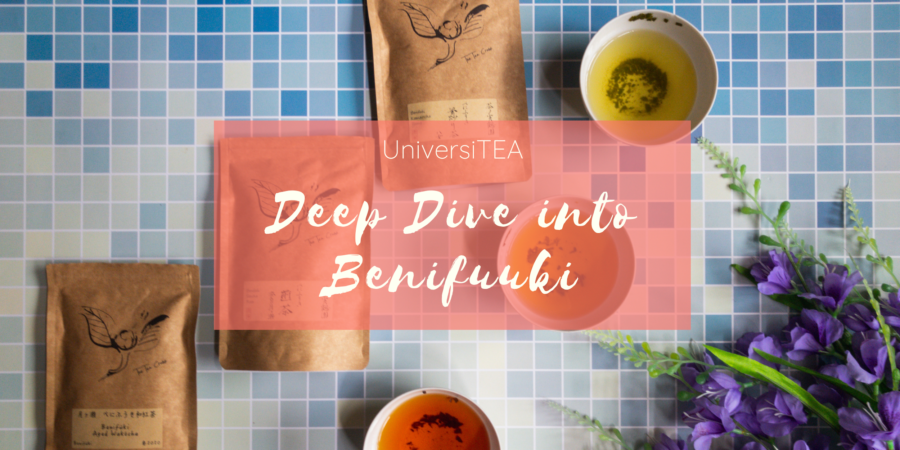Since I had the opportunity to try two new types of Benifuuki (ベニふうき/紅富貴/sometimes written Benifūki) tea, I thought it would be fun (and hopefully educational) to do a deep dive into this cultivar.
What is the Benifuuki Cultivar?
Developed by the National Institute of Vegetable and Tea Science (野菜茶業研究所), the Benifuuki cultivar is a cross between Benihomare [1], which has some metaphorical roots in Assam, and 枕 (Makura) Cd86 [2], which has roots in Darjeeling. As you can imagine, with roots from two places well known for their black teas, the Benifuuki cultivar was created to be oxidised either fully as a black tea or partially as an oolong.
One interesting thing about this cultivar is that it’s supposed to be helpful in combating allergic reactions as it’s high in methylated catechin (メチル化カテキン in Japanese)[3]. The green tea version is supposed to have the highest amount of this catechin, as this catechin decreases when this tea is oxidised [4]. If these health benefits interest you, read on to see what the studies say. Otherwise, feel free to skip to the section on how this cultivar tastes.
What do studies say about the Benifuuki?
The potential medical benefits of the methylated catechin in Benifuuki has caught the attention of scholars in Japan, and I managed to find a few papers about it.
In 2005, Yamamoto (Maeda) et all conducted a study where they studied the effects of Benifuuki [5] on three groups of people. Basically, they gave people in three groups three different mixtures [6] for 13 weeks and observed what happened. The sample size is pretty small (total 27 people, with 9 people in three groups) but basically they found that Benifuuki and Ginger work best to combat pollen allergies, followed by Benifuuki. The results from this study are supported by a slightly larger study (on 51 adults) carried out by Masuda et al in 2014 [7], where participants were divided into two groups and given either Benifuuki or Yabukita green tea, and the Benifuuki group reported lesser pollen allergy symptoms.
Apart from anti-allergy benefits, a 2009 study by Inagaki et al [8] on mice fed a high-fat diet indicated that Benifuuki may have a higher anti-obesity effect than Yabukita, an effect that was attributed to the methylated catechins found in Benifuuki tea.
Looking at the studies, it seems like the methylated catechins in Benifuuki is likely to help with pollen allergies, and given that these catechins are present in the highest amounts in green tea, Benifuuki green tea could work as a complement or addition to your regular pollen-fighting strategies.
Benifuuki Taste Comparison (Black Tea, Sencha, Kamairicha)
Since I had three different teas made from the Benifuuki cultivar, I thought I would be remiss if I didn’t compare the teas and try to see if we can draw any generalisations about the tea.

Dry Leaves 
Brewed Tea
So, using the tea tasting bowls from my Japanese Tea Instructor Course, I made three bowls of tea. I put in 3g of tea leave into each bowl and brewed with freshly boiled water for 2 minutes. It’s pretty amazing how different these teas were. To sum up my observations:
- The wakoucha (black tea) was sweet and floral and had very little bitterness. (My full review of the tea)
- The kamairicha (pan-fried green tea) also had a pronounced floral note but was also fairly bitter. Thankfully, this bitter note was somewhat balanced by another strong sweet note. (My full review of the tea)
- The sencha was my least favourite because not only did it not have any floral note, it was also bitter with strong vegetal and herbal notes (sorry to those who are looking to drink this for health benefits!). (My full review of the tea)
My theory is that the floral note present in the wakoucha and kamairicha is a part of the cultivar but might need oxidation or some other post-processing method to make it pronounced. Alternatively, it’s possible that the autumn harvest simply doesn’t contain a floral note. I also noticed that the greener the tea, the more prone to bitterness it seems to be. And given that I managed to get a medicinal note in the Benihomare black tea, it’s possible that the medicinal note in the Benifuuki sencha is from this, since Benihomare is one of the parent plants.
Overall, while the sencha and wakoucha taste completely different, the kamairicha stands between the two teas, with notes from both ends.
Ending Thoughts
I hope you agree that the Benifuuki is an interesting cultivar! While it’s highly likely that Benifuuki, especially the green tea version, contains allergy-fighting benefits, my favourite version of this tea is the black tea version. It’s sweet and floral and one of the most unique wakoucha’s that I’ve tried so far.

Notes
[1] I’ve actually tried a Benihomare black tea and you can see my review of it here
[2] From Wikipedia (Japanese)
[3] Full name: Epigallocatechin-3-O-(3-O-methyl) gallate
[4] From the National Agriculture Food and Research Organisation. This page also has a lot of good information on how to prepare the green tea version for maximum health benefits (basically, brew with freshly boiled water for 5 minutes. Unlike other sencha, you’ll want the water to be very hot because this catechin is more easily released into the tea in hot water).
[5] 山本(前田)万里, et al. “季節性アレルギー性鼻炎有症者を対象とした 「べにふうき」 緑茶の抗アレルギー作用評価とショウガによる増強効果.” 日本食品科学工学会誌 52.12 (2005): 584-593. (link to PDF)
[6] Mixture one: Benifuuki, Mixture two: Benifuuki + Ginger Extra, Mixture three (placebo): Yabukita
[7] Masuda, Sawako, et al. “‘Benifuuki’green tea containing o-methylated catechin reduces symptoms of Japanese cedar pollinosis: a randomized, double-blind, placebo-controlled trial.” Allergology International 63.2 (2014): 211-217. (link to PDF)
[8] 稲垣宏之, et al. “高脂肪飼料摂取マウスにおける 「べにふうき」 緑茶の脂肪蓄積抑制効果.” 日本食品科学工学会誌 56.7 (2009): 403-411. (link to PDF)

This is definitely an interesting one!
Yes! I’m really glad I found out about this cultivar!
It’ll be interesting to see if additional studies will be done, hopefully using methodology more reliable and measurable than a self-reported trial. Preliminary results are intriguing to be sure!
Yes! I’m also hoping for a much wider sample – everything now is pretty small scale. But still, very interesting results!
I also didn’t like Benifuuki sencha. It was too medicinal to me. If anyone wants to get the health benefits out of the green tea made from this cultivar, I strongly recommend going for the powdered form. Quite a number of producers make those, probably for customers like us. LOL. But I’ve tried a Benifuuki oolong before. Now that’s the good stuff, on par with its wakoucha. 😋
How is the powdered form? Is it also very medicinal in taste?
I really want to try the oolong now – if it’s on par with the wakoucha then I’m sure I’ll love it!
The powdered form I tried had a bit of sweetness to it. There was some bitterness but not as apparent as the green tea leaves. Plus you can adjust by adding more water and less powder to get the taste you prefer. Wakoen Global sells it, if you’re interested to try. As for Benifuuki oolong, I just saw What-cha has it. They likened it to Baozhong, so that should give you a rough idea of what to expect. 😄
Thank you! Time for me to quickly finish some teas so I can get more haha
Lovely review of the Benifuuki tea; I am reminded of when I used to review tea and this one was a challenge for me.
Thank you! Benifuuki is a lovely tea!
[…] more ephemeral (but sadly, not to the unique floral aspect that I’ve had from cultivars like Benifuuki or Yumewakaba). My preferences still lies towards the richer Chinese teas or perhaps even the more […]